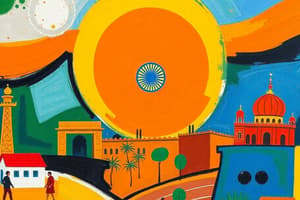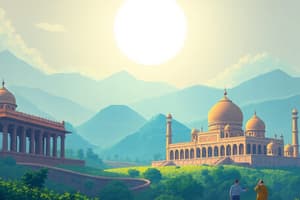Podcast
Questions and Answers
The primary objective of the book, Indian ______ Development, is to familiarize you with the basic features of the Indian economy and its development.
The primary objective of the book, Indian ______ Development, is to familiarize you with the basic features of the Indian economy and its development.
Economic
India had an ______ economy before the advent of the British rule, with agriculture as the main source of livelihood.
India had an ______ economy before the advent of the British rule, with agriculture as the main source of livelihood.
independent
The economic policies by the colonial government in India were more concerned with the protection and promotion of the economic interests of their ______ country.
The economic policies by the colonial government in India were more concerned with the protection and promotion of the economic interests of their ______ country.
home
The colonial government never made any sincere attempt to estimate India's ______ and per capita income, leading to conflicting results.
The colonial government never made any sincere attempt to estimate India's ______ and per capita income, leading to conflicting results.
India's economy under the British colonial rule remained fundamentally ______, with about 85% of the population living in villages.
India's economy under the British colonial rule remained fundamentally ______, with about 85% of the population living in villages.
______ became low though, in absolute terms, the agricultural sector experienced some growth due to the expansion of the aggregate area under cultivation.
______ became low though, in absolute terms, the agricultural sector experienced some growth due to the expansion of the aggregate area under cultivation.
Under the ______ system, implemented in the then Bengal Presidency, profits from agriculture went to the ______ instead of the cultivators.
Under the ______ system, implemented in the then Bengal Presidency, profits from agriculture went to the ______ instead of the cultivators.
Low levels of technology, lack of irrigation facilities, and negligible use of fertilisers contributed to the dismal level of agricultural ______.
Low levels of technology, lack of irrigation facilities, and negligible use of fertilisers contributed to the dismal level of agricultural ______.
Instead of producing food crops, farmers were producing ______ crops, which were to be ultimately used by British industries back home.
Instead of producing food crops, farmers were producing ______ crops, which were to be ultimately used by British industries back home.
As in agriculture, India could not develop a sound ______ base under colonial rule, with world-famous handicraft industries declining.
As in agriculture, India could not develop a sound ______ base under colonial rule, with world-famous handicraft industries declining.
Colonial government de-industrialising India was two-fold, first, to reduce India to the status of a mere exporter of raw materials, and second, to turn India into a sprawling ______ for finished products.
Colonial government de-industrialising India was two-fold, first, to reduce India to the status of a mere exporter of raw materials, and second, to turn India into a sprawling ______ for finished products.
The decline of indigenous handicraft industries created massive unemployment and a new demand in the Indian consumer market, which was met by increasing imports of cheap manufactured goods from ______.
The decline of indigenous handicraft industries created massive unemployment and a new demand in the Indian consumer market, which was met by increasing imports of cheap manufactured goods from ______.
During the second half of the nineteenth century, modern industry began to take root in India, confined to cotton and jute mills, but it's progress remained very ______.
During the second half of the nineteenth century, modern industry began to take root in India, confined to cotton and jute mills, but it's progress remained very ______.
The Tata Iron and Steel Company (______) was incorporated in 1907, marking the beginning of iron and steel industries in India.
The Tata Iron and Steel Company (______) was incorporated in 1907, marking the beginning of iron and steel industries in India.
There was hardly any ______ goods industry to help promote further industrialisation in India.
There was hardly any ______ goods industry to help promote further industrialisation in India.
The growth rate of the new industrial sector and its contribution to the Gross Domestic Product (______) or Gross Value Added remained very small.
The growth rate of the new industrial sector and its contribution to the Gross Domestic Product (______) or Gross Value Added remained very small.
Restrictive policies of commodity production, trade, and tariff pursued by the colonial government adversely affected the structure, composition, and volume of India's ______ trade.
Restrictive policies of commodity production, trade, and tariff pursued by the colonial government adversely affected the structure, composition, and volume of India's ______ trade.
Britain maintained a ______ control over India's exports and imports, restricting more than half of India's foreign trade to Britain.
Britain maintained a ______ control over India's exports and imports, restricting more than half of India's foreign trade to Britain.
The most crucial characteristic of India's foreign trade throughout the colonial period was a large ______ surplus at a huge economic cost.
The most crucial characteristic of India's foreign trade throughout the colonial period was a large ______ surplus at a huge economic cost.
The export surplus during the colonial period did not result in a flow of gold or silver into India; rather, it was used to make payments in Britain, expenses on war, and import of ______.
The export surplus during the colonial period did not result in a flow of gold or silver into India; rather, it was used to make payments in Britain, expenses on war, and import of ______.
Details about the population of British India were first collected through a ______ in 1881, revealing unevenness in India's population growth.
Details about the population of British India were first collected through a ______ in 1881, revealing unevenness in India's population growth.
Before 1921, India was in the first stage of ______ transition; the second stage began after 1921.
Before 1921, India was in the first stage of ______ transition; the second stage began after 1921.
The overall literacy level in India was less than 16%, and the female literacy level was at a negligible low of about ______ percent.
The overall literacy level in India was less than 16%, and the female literacy level was at a negligible low of about ______ percent.
During the colonial period, the occupational structure of India showed little sign of change, with the agricultural sector accounting for the ______ share of the workforce.
During the colonial period, the occupational structure of India showed little sign of change, with the agricultural sector accounting for the ______ share of the workforce.
Under the colonial regime, basic ______, such as railways, ports, and telegraphs, were developed to subserve various colonial interests.
Under the colonial regime, basic ______, such as railways, ports, and telegraphs, were developed to subserve various colonial interests.
Roads were built during that time to mobilize the army and draw out raw materials to send these to England or other lucrative destinations. There was a huge ______ on roads reaching to all other areas.
Roads were built during that time to mobilize the army and draw out raw materials to send these to England or other lucrative destinations. There was a huge ______ on roads reaching to all other areas.
The British introduced the ______ in India in the 1850's, which is one of their most important contributions as commercialization of india was heavily affected.
The British introduced the ______ in India in the 1850's, which is one of their most important contributions as commercialization of india was heavily affected.
By the time of India's independence, the British had implemented an industrial sector oriented towards feeding what event in Britain?
By the time of India's independence, the British had implemented an industrial sector oriented towards feeding what event in Britain?
By the time India was independent, agriculture was already filled with ______ labor and low production
By the time India was independent, agriculture was already filled with ______ labor and low production
The economic policies were more concerned with the protection of British interests that promoting India's condition.
The economic policies were more concerned with the protection of British interests that promoting India's condition.
India was not capable of replacing its ______ industries with a modern base given British control.
India was not capable of replacing its ______ industries with a modern base given British control.
What canal further restricted Indian control but provided access to the British
What canal further restricted Indian control but provided access to the British
During the colonial period, there was virtually no change to the ______ makeup of the economy.
During the colonial period, there was virtually no change to the ______ makeup of the economy.
What was the average year of death, on average, compared to the 69 of current times?
What was the average year of death, on average, compared to the 69 of current times?
Before what year was India in the fist stage of transition, and not the second?
Before what year was India in the fist stage of transition, and not the second?
Give the word for when British interests were served, as opposed to what they said their motivation was.
Give the word for when British interests were served, as opposed to what they said their motivation was.
In some ways, the colonial government tried to limit the reliance on a ______ economy, but that proved to be difficult.
In some ways, the colonial government tried to limit the reliance on a ______ economy, but that proved to be difficult.
The colonial government provided money for war, but the ______ suffered the most.
The colonial government provided money for war, but the ______ suffered the most.
The intention of the industrialization was to turn India into more of a ______.
The intention of the industrialization was to turn India into more of a ______.
Under Brtitish rule, there was a huge loss and a smaller ______
Under Brtitish rule, there was a huge loss and a smaller ______
The railways helped the British, but it harmed Indian's ______
The railways helped the British, but it harmed Indian's ______
Flashcards
Primary objective of 'Indian Economic Development' book
Primary objective of 'Indian Economic Development' book
To familiarize with the basic features of the Indian economy and its development after independence.
Sole purpose of British colonial rule in India
Sole purpose of British colonial rule in India
India was reduced to a raw material supplier for Great Britain's industrial base.
India's manufacturing activities before British rule
India's manufacturing activities before British rule
India was well known for its handicraft industries, like cotton and silk textiles.
What is Muslin?
What is Muslin?
Signup and view all the flashcards
What is 'malmal shahi'?
What is 'malmal shahi'?
Signup and view all the flashcards
Focus of economic policies by the colonial government in India
Focus of economic policies by the colonial government in India
Signup and view all the flashcards
Fundamental change in Indian economy due to colonial policies
Fundamental change in Indian economy due to colonial policies
Signup and view all the flashcards
Colonial government's effort to measure India's income
Colonial government's effort to measure India's income
Signup and view all the flashcards
India's economy under British colonial rule
India's economy under British colonial rule
Signup and view all the flashcards
Under the zamindari system, to whom did the profit go?
Under the zamindari system, to whom did the profit go?
Signup and view all the flashcards
Main interest of the zamindars
Main interest of the zamindars
Signup and view all the flashcards
Instead of food crops, what were the farmers producing?
Instead of food crops, what were the farmers producing?
Signup and view all the flashcards
Manufacturing under the colonial rule
Manufacturing under the colonial rule
Signup and view all the flashcards
Second intention of de-industrializing India
Second intention of de-industrializing India
Signup and view all the flashcards
What is capital goods industry?
What is capital goods industry?
Signup and view all the flashcards
India's economy in terms of trade
India's economy in terms of trade
Signup and view all the flashcards
What was the export surplus used for?
What was the export surplus used for?
Signup and view all the flashcards
What is the Suez Canal?
What is the Suez Canal?
Signup and view all the flashcards
British India population details
British India population details
Signup and view all the flashcards
India before 1921 and demographic transition
India before 1921 and demographic transition
Signup and view all the flashcards
Infant mortality rate
Infant mortality rate
Signup and view all the flashcards
Life expectancy in India
Life expectancy in India
Signup and view all the flashcards
Occupational structure of India
Occupational structure of India
Signup and view all the flashcards
Largest share of workforce
Largest share of workforce
Signup and view all the flashcards
Real motive behind the development
Real motive behind the development
Signup and view all the flashcards
Railways in India and time
Railways in India and time
Signup and view all the flashcards
Result of the railways
Result of the railways
Signup and view all the flashcards
Study Notes
-
Unit I focuses on development policies and experiences from 1947-1990
-
The unit will overview the Indian economy's state at independence and four decades of planned development.
-
It will cover the government's steps, the establishment of the Planning Commission, and five-year plans.
-
There will be a critical analysis of planned development's merits and limitations.
Indian Economy on the Eve of Independence
- It will familiarize with the Indian economy's state in 1947
- It aims to understand the factors that led to underdevelopment and stagnation.
Introduction
- The primary objective is to familiarize with Indian economy's basic features and development after independence.
- Understanding the country's economic past is vital for learning about its present and future.
- Pre-independence economic state and factors shaping post-independence development strategy is also important.
- India's present-day economy has roots in history, particularly during British rule.
- British colonial rule aimed to reduce India to a raw material supplier for Great Britain's industrial base.
- Understanding this exploitative relationship is essential for assessing India's development.
Low Level of Economic Development under the Colonial Rule
- India had an independent economy before British rule.
- Agriculture was the main livelihood but economy featured various manufacturing activities.
- India was known for handicraft industries like cotton and silk textiles, metal, and precious stone work.
- These products had a worldwide market due to fine quality and craftsmanship.
Textile Industry in Bengal
-
Muslin, a cotton textile, originated in Bengal, especially around Dhaka.
-
'Daccai Muslin' gained worldwide fame as an exquisite cotton textile.
-
The finest variety was called malmal, sometimes referred to as malmal shahi or malmal khas for royalty.
-
British economic policies prioritized their home country's interests over India's development.
-
Policies caused a fundamental change, turning India into a raw material supplier and consumer of finished British products.
-
The colonial government did not attempt to estimate India's national and per capita income.
-
Individual attempts to measure incomes yielded conflicting results.
-
Estimators included Dadabhai Naoroji, William Digby, Findlay Shirras, V.K.R.V. Rao, and R.C. Desai; Rao's estimates were considered significant.
-
Most studies found that during the first half of the twentieth century the country's growth of output was around two per cent coupled with a meagre half per cent growth in per capita output per year.
Agriculture During Pre-British India
- A French traveler described seventeenth-century Bengal as richer than Egypt.
- Bengal exported cottons, silks, rice, sugar, and butter.
- Produced ample wheat, vegetables, grains, fowls, ducks, and geese for local consumption.
- Possessed immense herds of pigs and flocks of sheep and goats, with profusion of fish.
- Abundant canals from rajmahal to the sea, created for navigation and irrigation.
Agricultural Sector
-
India's economy remained fundamentally agrarian under British rule, with about 85% of the population living in villages.
-
Despite a large population depending on it, agriculture experienced stagnation and deterioration.
-
Agricultural productivity became low; the sector experienced some growth due to the expansion of cultivation.
-
Stagnation was mainly due to land settlement systems introduced by the government.
-
Under the zamindari system in the Bengal Presidency, profit went to zamindars instead of cultivators.
-
Zamindars did little to improve agriculture, focusing on rent collection regardless of cultivators' economic condition, causing misery and social tension.
-
Terms of revenue settlement also influenced zamindars; fixed dates for depositing revenue, leading to loss of rights.
-
Low technology, lack of irrigation, and negligible fertilizer use worsened plight of farmers and productivity.
-
Some evidence of relatively higher yields of cash crops in certain areas because of commercialisation of agriculture.
-
Cash crop production didn't improve farmer conditions, benefiting British industries.
-
Despite irrigation progress, agriculture lacked investment in terracing, flood control, drainage, and soil desalinization.
-
Small number of farmers switched from food crops to commercial crops.
-
Most tenants, small farmers, and sharecroppers lacked resources, technology, and incentives to invest.
Industrial Sector
- India did not developed a sound industrial base under colonial rule.
- Existing handicraft industries declined as no modern industrial base was allowed to emerge.
- Colonial government's policy of de-industrializing India was mainly for two reasons.
- The reasons was to reduce India to raw material exporter for Britain's modern industries.
- The other reason was to turn India into a market for the finished products of those industries.
- Decline of indigenous handicraft industries caused unemployment and created a new consumer demand of locally made goods.
- New opportunities were profitably met by cheap manufactured goods from Britain.
- Modern industry began in India during the second half of the nineteenth century but it was very slow.
- It was confined to cotton and jute textile mills, dominated by Indians and foreigners, respectively.
- Tata Iron and Steel Company (TISCO) began in the twentieth century in 1907.
- A few other industries in sugar, cement, paper etc. came up after Second World War.
- Hardly any capital goods industry promoted industrialisation in India.
- The establishment of a few manufacturing units was no substitute for the country's traditional handicrafts.
- The new industrial sector barely contributed to country's growth.
- Limited operation of the public sector, confined to railways, power generation, communications, ports, and some departments.
Foreign Trade
- India was an important trading nation.
- Colonial government's restrictive policies on commodity production, trade, and tariff adversely affected India's trade.
- India became an exporter of primary products and an importer of finished goods.
- Britain maintained a monopoly over India's exports and imports.
- More than half of India's foreign trade was restricted to Britain.
- The opening of the Suez Canal intensified British control over India's trade
- Colonial period India had a large export surplus.
- The surplus came at the cost of the country's economy.
- Essential commodities were scarcely available in the domestic market.
- This export surplus was used to pay expenses and war.
- All these factors led to the drain of Indian wealth.
Trade Through the Suez Canal
- Suez Canal is an artificial waterway running north to south across the Isthmus of Suez in Egypt.
- Connects Port Said on the Mediterranean Sea with the Gulf of Suez.
- Direct trade route for ships operating between European/American ports and ports in South Asia, East Africa and Oceania.
- Doing away the need to sail around Africa.
- Strategically and economically, it is one of the most important waterways in the world.
- 1869 opening reduced transportation cost and the Indian market easier to access.
Demographic Condition
- Population details of British India were first collected through a census in 1881.
- Census revealed the unevenness in India's population growth.
- Before 1921, India was in the first stage of demographic transition
- The second stage began after 1921.
- Population and growth rate were not very high.
- Social development indicators were not encouraging.
- Overall literacy was less than 16 per cent.
- Female literacy was at a negligible low of about seven per cent.
- Public health facilities were unavailable to large chunks of population and inadequate.
- The water- and air-borne diseases were rampant and took a huge toll on life.
- The overall mortality rate was very high, especially for children.
- Infant mortality rate was about 218 per thousand in contrast to present 33 per thousand.
- Life expectancy was also very low-32 years in contrast to the present 69 years.
- Extensive poverty that prevailed in India during the era contributed to the deteriorating profile of India's population.
Occupational Structure
- India witnessed little change in the occupational structure during the period.
- The agricultural sector accounted for largest share of workforce.
- The workforce share usually remained at a high of 70-75 per cent while the manufacturing and the services sectors accounted for only 10 and 15-20 per cent respectively.
- Regional variations were another striking aspect.
- Parts of the then Madras Presidency, Bombay and Bengal, saw a decline in the workforce dependence on the agricultural sector with an increase in the areas for manufacturing.
- Share of workforce for agriculture increased in states such as Orissa, Rajasthan and Punjab.
Infrastructure
-
Despite development of Railways, Ports, Water transport, and telegraphs; it was not to provide conveniences to people but to subserve various colonial interests.
-
Pre-British roads in India were not fit for modern transport.
-
The new roads primarily served for mobilisation.
-
Acute shortage remained during rainy season.
-
In 1850, the British introduced roadways in India which is considered as one of their contributions.
-
Railways affected the structure of the Indian economy by enabling long distance travel and breaking geographical and cultural barriers and fostering commercialisation.
-
But the commercialisation adversely affected self-sufficiency of the village economies.
-
This volume of India exports got expanded but its benefits were rarely accrued the Indian people.
-
Measures taken for inland trade and sea lanes were still not satisfactory.
-
The inland waterways proved uneconomical as in the case of the Coast Canal on the Orissa.
-
Electric telegraph systems served purpose of maintaining a good law and order.
-
Cost to the government exchequer was high.
-
Postal services remained inadequate.
Conclusion
- India got saddled with surplus labour, very low productivity.
- The Industrial Sector needed modernisatiion, diversification and capacity building.
- The foreign trade catered needs of British.
- Need to improve basic ammenities, infrastructure.
- Prevalence of poverty.
- Social and economic challenges were enormous.
Studying That Suits You
Use AI to generate personalized quizzes and flashcards to suit your learning preferences.




